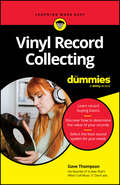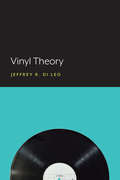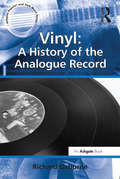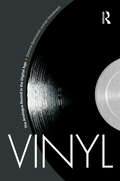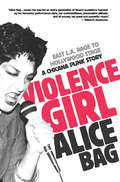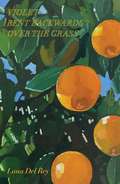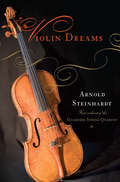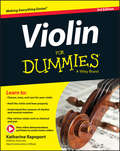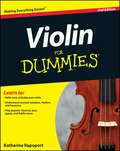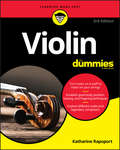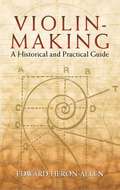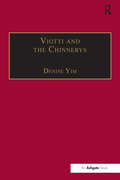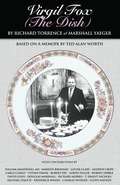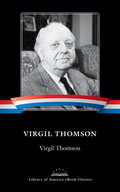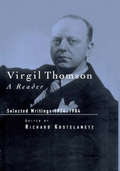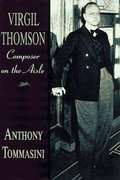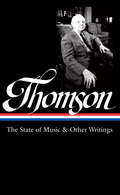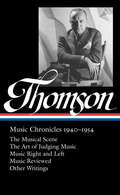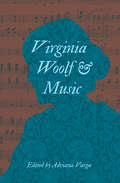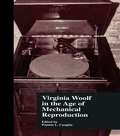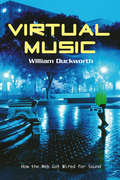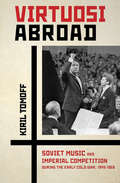- Table View
- List View
Vinyl Record Collecting For Dummies
by Dave ThompsonGet on the vinyl train and learn about this captivating hobby Vinyl Record Collecting For Dummies teaches you how to start a collection, grow your collection, and make that collection sound excellent. You’ll learn how to shop for new, used, and rare records, and how to select the turntable that’s right for you. Learn how to determine a record’s value, build your collection on a budget, and properly store and maintain your records. This handy Dummies guide also gives you the background knowledge you’ll need to hold your own in conversations with vinyl enthusiasts—all about music genres, the pros and cons of vinyl types, how records are made, and even the history of record collecting itself. Now you can start collecting rare records, new releases, and everything in between. Learn the basics of buying records at record shops, secondhand stores, and online Determine the value of your collection and learn how to recognize great deals Select the turntable and sound system that are right for your needs Explore the history of recorded music and learn why people are going wild for vinyl This is the perfect Dummies guide for anyone who’s ready to get swept up in the excitement of collecting vinyl records, including beginners and seasoned collectors.
Vinyl Theory
by Jeffrey R. Di LeoWhy are vinyl records making a comeback? How is their resurgence connected to the political economy of music? Vinyl Theory responds to these and other questions by exploring the intersection of vinyl records with critical theory. In the process, it asks how the political economy of music might be connected with the philosophy of the record. The young critical theorist and composer Theodor Adorno’s work on the philosophy of the record and the political economy of music of the contemporary French public intellectual, Jacques Attali, are brought together with the work of other theorists in order to understand the fall and resurrection of vinyl records. The major argument of Vinyl Theory is that the very existence of vinyl records may be central to understanding the resiliency of neoliberalism. This argument is made by examining the work of Adorno, Attali, Friedrich Nietzsche, and others on music through the lens of Michel Foucault’s biopolitics.
Vinyl: A History Of The Analogue Record (Ashgate Popular and Folk Music Series)
by Richard OsborneVinyl: A History of the Analogue Record is the first in-depth study of the vinyl record. Richard Osborne traces the evolution of the recording format from its roots in the first sound recording experiments to its survival in the world of digital technologies. This book addresses the record's relationship with music: the analogue record was shaped by, and helped to shape, the music of the twentieth century. It also looks at the cult of vinyl records. Why are users so passionate about this format? Why has it become the subject of artworks and advertisements? Why are vinyl records still being produced? This book explores its subject using a distinctive approach: the author takes the vinyl record apart and historicizes its construction. Each chapter explores a different element: the groove, the disc shape, the label, vinyl itself, the album, the single, the b-side and the 12" single, and the sleeve. By anatomizing vinyl in this manner, the author shines new light on its impact and appeal.
Vinyl: The Analogue Record in the Digital Age
by Ian Woodward Dominik BartmanskiRecent years have seen not just a revival, but a rebirth of the analogue record. More than merely a nostalgic craze, vinyl has become a cultural icon. As music consumption migrated to digital and online, this seemingly obsolete medium became the fastest-growing format in music sales. Whilst vinyl never ceased to be the favorite amongst many music lovers and DJs, from the late 1980s the recording industry regarded it as an outdated relic, consigned to dusty domestic corners and obscure record shops. So why is vinyl now experiencing a ‘rebirth of its cool’?Dominik Bartmanski and Ian Woodward explore this question by combining a cultural sociological approach with insights from material culture studies. Presenting vinyl as a multifaceted cultural object, they investigate the reasons behind its persistence within our technologically accelerated culture. Informed by media analysis, urban ethnography and the authors’ interviews with musicians, DJs, sound engineers, record store owners, collectors and cutting-edge label chiefs from a range of metropolitan centres renowned for thriving music scenes including London, New York, Tokyo, Melbourne, and especially Berlin, what emerges is a story of a modern icon.
Violence Girl
by Alice BagThe proximity of the East L.A. barrio to Hollywood is as close as a short drive on the 101 freeway, but the cultural divide is enormous. Born to Mexican-born and American-naturalized parents, Alicia Armendariz migrated a few miles west to participate in the free-range birth of the 1970s punk movement. Alicia adopted the punk name Alice Bag, and became lead singer for The Bags, early punk visionaries who starred in Penelope Spheeris' documentary The Decline of Western Civilization. Here is a life of many crossed boundaries, from East L.A.'s musica ranchera to Hollywood's punk rock; from a violent male-dominated family to female-dominated transgressive rock bands. Alice's feminist sympathies can be understood by the name of her satiric all-girl early Goth band Castration Squad. Violence Girl takes us from a violent upbringing to an aggressive punk sensibility; this time a difficult coming-of-age memoir culminates with a satisfying conclusion, complete with a happy marriage and children. Nearly a hundred excellent photographs energize the text in remarkable ways. Alice Bag's work and influence can be seen this year in the traveling Smithsonian exhibition "American Sabor: Latinos in U.S. Popular Music."
Violet Bent Backwards Over the Grass
by Lana Del ReyThe New York Times bestselling debut book of poetry from Lana Del Rey, Violet Bent Backwards Over the Grass.&“Violet Bent Backwards Over the Grass is the title poem of the book and the first poem I wrote of many. Some of which came to me in their entirety, which I dictated and then typed out, and some that I worked laboriously picking apart each word to make the perfect poem. They are eclectic and honest and not trying to be anything other than what they are and for that reason I&’m proud of them, especially because the spirit in which they were written was very authentic.&” —Lana Del Rey Lana&’s breathtaking first book solidifies her further as &“the essential writer of her times&” (The Atlantic). The collection features more than thirty poems, many exclusive to the book: Never to Heaven, The Land of 1,000 Fires, Past the Bushes Cypress Thriving, LA Who Am I to Love You?, Tessa DiPietro, Happy, Paradise Is Very Fragile, Bare Feet on Linoleum, and many more. This beautiful hardcover edition showcases Lana&’s typewritten manuscript pages alongside her original photography. The result is an extraordinary poetic landscape that reflects the unguarded spirit of its creator. Violet Bent Backwards Over the Grass is also brought to life in an unprecedented spoken word audiobook which features Lana Del Rey reading fourteen select poems from the book accompanied by music from Grammy Award–winning musician Jack Antonoff.
Violet's Music
by Angela Johnson Laura Huliska-BeithThere's nothing Violet loves more than music, and she plays or sings every chance she gets. But where are the other kids like her-kids who think and dream music all day long? As a baby, in kindergarten, at the beach and the zoo, she never gives up looking for companions. And then one summer day. . . Bright, lively, and lyrical, this is a book for kids who march to a different drummer. "Violet's Music" sings to us that the right friend is always out there-as long as we keep looking and hoping, and above all, staying true to ourselves. "
Violin Dreams
by Arnold Steinhardt"A rapturous, witty, and passionate memoir ... Violin Dreams is not only the story of a man becoming an artist, it's a history of twentieth-century music." -- John Guare, Tony Award-winning playwright Arnold Steinhardt, for more than forty years an international soloist and the first violinist of the Guarneri String Quartet, brings warmth, wit, and fascinating insider details to the story of his lifelong obsession with the violin, that most seductive and stunningly beautiful instrument. His story is rich with vivid scenes: the terror inflicted by his early violin teachers, the sensual pleasure involved in the pursuit of the perfect violin, the charged atmosphere of high-level competitions. Steinhardt describes Bach's Chaconne as the holy grail for the solo violin, and he illuminates, from the perspective of an ardent owner of a great Storioni violin, the history and mysteries of the renowned Italian violinmakers. Violin Dreams includes a remarkable audio recording of Steinhardt performing Bach's Partita in D Minor as a young violinist forty years ago and playing the same piece especially for this book. A conversation between the author and Alan Alda on the differences between the two performances is included in the ebook.
Violin Dreams
by Arnold Steinhardt"A rapturous, witty, and passionate memoir ... Violin Dreams is not only the story of a man becoming an artist, it's a history of twentieth-century music." -- John Guare, Tony Award-winning playwright Arnold Steinhardt, for more than forty years an international soloist and the first violinist of the Guarneri String Quartet, brings warmth, wit, and fascinating insider details to the story of his lifelong obsession with the violin, that most seductive and stunningly beautiful instrument. His story is rich with vivid scenes: the terror inflicted by his early violin teachers, the sensual pleasure involved in the pursuit of the perfect violin, the charged atmosphere of high-level competitions. Steinhardt describes Bach's Chaconne as the holy grail for the solo violin, and he illuminates, from the perspective of an ardent owner of a great Storioni violin, the history and mysteries of the renowned Italian violinmakers. Violin Dreams includes a remarkable audio recording of Steinhardt performing Bach's Partita in D Minor as a young violinist forty years ago and playing the same piece especially for this book. A conversation between the author and Alan Alda on the differences between the two performances is included in the ebook.
Violin For Dummies
by Katharine RapoportThe beginner's guide to learning the violin -- for any musical style Violin For Dummies helps you teach yourself to play the violin, even if you've never read a note of music. From choosing the right violin for you to playing a variety of musical styles, this book has you covered. You'll start with the basics of posture and bowing technique, learn how to tune your instrument and keep it in beautiful condition with regular maintenance. You'll learn how to read -- and feel -- the music, and how to inject your own personality into whatever you play. Before you know it, you'll be playing classical, jazz, country, and more, as you become a bona fide violin player. The included audio and video instruction encourages you to play along as you learn, and allow you to hear, see, and imitate proper technique. The violin's small size, portability, and mimicry of the human voice have made it popular across cultures and throughout time. This book shows you how to teach yourself the basics so you can start playing quickly. Start with the basics of proper hold and bowing technique Learn how to properly tune and care for your violin Understand the nuances of rhythm and musical notation Play classical, jazz, and other popular styles of music The violin has a reputation of being difficult to learn, but the reality is that it's difficult to master. Anyone can learn, and practice over time will refine your technique and your musical style. You'll have fun, make music, and maybe even fall in love with this instrument that has inspired some of the world's best musicians and composers. Get started today, the easy way, with Violin For Dummies.
Violin For Dummies, 2nd Edition
by Katharine RapoportThe bestselling guide to teaching yourself the violin just got betterDespite being one of the most popular musical instruments for budding musicians, the violin has a reputation as being amongst the most difficult to learn. But no longer. Violin for Dummies is packed with the information you need to learn the art of this beautiful instrument, whether you're looking to get a head start before taking up lessons or are already studying with a tutor but want a little boost. With this book you have everything you need to get started.Even if you've never read a note of music, this book will have you playing in no time, introducing you to the fundamentals of the violin, from selecting and tuning to understanding rhythm, musical notation, and harmony.Walks you through everything from how to hold your violin to playing popular classical, jazz, gypsy, and fiddle tunesFilled with all-new content, including new music and updated resourcesDesigned for aspiring musicians going it alone, the book can also serve as an invaluable aid for instructors Fully revised and updated, Violin For Dummies builds on the winning formula that made the original a bestseller, establishing it as the only book the aspiring violinist needs to get started.CD-ROM/DVD and other supplementary materials are not included as part of the e-book file, but are available for download after purchase
Violin For Dummies: Book + Online Video and Audio Instruction
by Katharine RapoportTurn notes on a staff to notes on your strings Establish good body position, bowing, and fingering techniques Explore different styles and legendary composers Draw beautiful sounds from your violin! While learning the violin is a formidable goal, you don't have to be a music genius to grasp the basics. And with practice, the payoff will be music to your ears—plus a world of musical opportunity. This book starts you on the path to mastering the instrument that is central to musical cultures throughout the world. Playing along with the lessons in this friendly step-by-step guide will take you from first notes to performing entire songs—and you'll be glad you added this string to your bow! Inside... Choose your instrument Hold your violin correctly Play scales and chords Understand notation Master different music styles Tune and care for your instrument Find practice files online
Violin-Making: A Historical and Practical Guide
by Edward Heron-AllenThis classic guide offers an accessible initiation into the mysteries of violin-making. Charming in its style and cultivated in its research, it covers every detail of the process, from wood selection to varnish. A fascinating history of the instrument precedes discussions of materials and construction techniques. More than 200 diagrams, engravings, and photographs complement the text.Author Edward Heron-Allen served an apprenticeship with Georges Chanot, a preeminent nineteenth-century violin maker. The knowledge, skill, and experience Heron-Allen acquired in the master's shop are reflected in this book, which was the first to combine the history, theory, and practice of violin-making. Originally published in 1884 as Violin-Making, As It Was and Is: Being a Historical, Theoretical and Practical Treatise on the Science and Art of Violin-Making for the Use of Violin Makers and Players, Amateur and Professional, this volume has enlightened and informed generations of performers and players alike.
Violin: An Introduction To The Instrument
by William BallantineA beginner's guide to the violin. Among other topics, this book describes the history of the violin, how violins are made, and how they are used in different musical genres.
Viotti and the Chinnerys: A Relationship Charted Through Letters (Music In Nineteenth-century Britain Ser.)
by Denise YimThe Italian violinist and composer Giovanni Battista Viotti (1755-1824) is considered today to have been one of the most significant forces in the history of violin playing. In 1792 he met Margaret and William Chinnery, a wealthy English couple with strong connections in the world of arts and letters. From that point onwards Viotti's life became inextricably bound up with theirs; he moved into their home and became a second father to their children, forming a remarkably successful m gerois. Henceforth, all Viotti's career decisions were taken with this family's welfare in mind. The Chinnery Family Papers feature over 100 Viotti letters and other documents. Drawing extensively on these papers, this book investigates the new light that they cast on Viotti's life and career, as well as the context in which he lived and worked. Fresh insights are given into the reception of Viotti's concertos in London and the solo performances he gave while in England, together with new information on his role as a music teacher in the Chinnery household, and his relationship with Mme de Sta and the Philharmonic Society.
Virgil Fox (The Dish)
by Richard Torrence Marshall Yaeger(This version (5th printing) has been updated as of January, 2014) A spicy biography of the late Virgil Fox (1912-1980), who was one of the most successful and famous organists in history. Written by the organist's managers for 17 years, the book is based on a 375-page memoir of Fox's artistic heir and protege, Ted Alan Worth. Includes contributions by 17 other associates and students who knew Fox intimately, including Carlo Curley, Fred Swann, Albert Fuller, and Richard Morris.
Virgil Thomson: A Library of America E-Book Classic
by Virgil ThomsonVirgil Thomson was a gifted composer and one of the nation's foremost cultural critics. The best-selling autobiography Virgil Thomson (1966) is his gossipy telling of his own extraordinary progress from unteachable smart aleck to revered elder statesman. It recounts his artistically precocious Kansas City boyhood, demanding Harvard education, apprenticeship in Paris between the wars, and hard-won musical and literary maturity in New York. As narrator and protagonist, Thomson fascinates not only with his own story but also with those of his associates, collaborators, friends, and rivals, among them Gertrude Stein, Alice B. Toklas, Ezra Pound, James Joyce, Nadia Boulanger, George Antheil, Pablo Picasso, Jean Cocteau, Max Jacob, Pare Lorentz, John Houseman, and Orson Welles. Virgil Thomson is an authentic work of Americana and a first-rate, first-person history of the rise of modernism.Complete with 32 pages of photographs.
Virgil Thomson: A Reader: Selected Writings, 1924-1984
by Richard KostelanetzThis essential reader includes Thomson's essays on making a living as a musician; his articles on classic composers; his relation to his contemporaries; his articles on newcomers in the music world, including John Cage and Pierre Boulez; his autobiographical writings and commentary on his own works.
Virgil Thomson: Composer on the Aisle
by Anthony TommasiniIn the first full-scale biography of a dominating figure in twentieth-century American music, Anthony Tommasini tells the richly textured story of Virgil Thomson's experiences as a composer, influential critic, and gay man. Writing with exclusive, full access to Thomson's papers and from extensive interviews and research, he recounts: Thomson's early years in turn-of-the-century Kansas City's strange mixture of antebellum racial divides. . . his first steps in the arts, guided by a troubled older man, himself a closeted homosexual in a time when disclosure could destroy a life. . . the crystallizing of his musical ambitions as an often-contentious student of Nadia Boulanger's in Paris. . . his pioneering collaboration with Gertrude Stein on Four Saints in Three Acts. . . his rivalry with fellow composers such as Aaron Copland. . . how he settled personal scores and advanced his own agenda during his reign on the New York Herald Tribune as America's most important, and best, music critic. . . his lasting impact on, and sometimes troubled interactions with, younger composers such as Leonard Bernstein, John Cage, Paul Bowles, Ned Rorem, and Philip Glass. . . and through it all the unending struggle to write, and win an audience for, music that spoke directly and simply to the life of his time. --BOOK JACKET. Title Summary field provided by Blackwell North America, Inc. All Rights Reserved
Virgil Thomson: Library of America #277
by Tim Page Virgil ThomsonAn unprecedented collection of polemical and autobiographical writings by America's greatest composer-critic. Following on the critically acclaimed 2014 edition of Virgil Thomson's collected newspaper music criticism, The Library of America and Pulitzer Prize-winning music critic Tim Page now present Thomson's other literary and critical works, a body of writing that constitutes America's musical declaration of independence from the European past. This volume opens with The State of Music (1939), the book that made Thomson's name as a critic and won him his 14-year stint at the New York Herald Tribune. This no-holds-barred polemic, here presented in its revised edition of 1962, discusses the commissions, jobs, and other opportunities available to the American composer, a worker in a world of performance and broadcast institutions that, today as much as in Thomson's time, are dominated by tin-eared, non-musical patrons of the arts who are shocked by the new and suspicious of native talent. Thomson's autobiography, Virgil Thomson (1966), is more than just the story of the struggle of one such American composer, it is an intellectual, aesthetic, and personal chronicle of the twentieth century, from World War I-era Kansas City to Harvard in the age of straw boaters, from Paris in the Twenties and Thirties to Manhattan in the Forties and after. A classic American memoir, it is marked by a buoyant wit, a true gift for verbal portrait-making, and a cast of characters including Aaron Copland, Gertrude Stein, James Joyce, Paul Bowles, John Houseman, and Orson Welles. American Music Since 1910 (1971) is a series of incisive essays on the lives and works of Ives, Ruggles, Varèse, Copland, Cage, and others who helped define a national musical idiom. Music with Words (1989), Thomson's final book, is a distillation of a subject he knew better than perhaps any other American composer: how to set English--especially American English--to music, in opera and art song. The volume is rounded out by a judicious selection of Thomson's magazine journalism from 1957 to 1984--thirty-seven pieces, most of them previously uncollected, including many long-form review-essays written for The New York Review of Books.From the Hardcover edition.
Virgil Thomson: Music Chronicles, 1940-1954 - The Musical Scene; The Art Of Judging Music; Music Right And Left; Music Reviewed; Other Writings (Library of America Virgil Thomson Edition #1)
by Tim Page Virgil ThomsonRevisit the Golden Age of classical music in America through the witty and adventurous reviews of our greatest critic-composer: For fourteen memorable years Virgil Thomson surveyed the worlds of opera and classical music as the chief music critic for the New York Herald Tribune. An accomplished composer who knew music from the inside, Thomson communicated its pleasures and complexities to a wide readership in a hugely entertaining, authoritative style, and his daily reviews and Sunday articles set a high-water mark in American cultural journalism. Thomson collected his newspaper columns in four volumes: The Musical Scene, The Art of Judging Music, Music Right and Left, and Music Reviewed. All are gathered here, together with a generous selection of Thomson's uncollected writings. The result is a singular chronicle of a magical time when an unrivaled roster of great conductors (Koussevitzky, Toscanini, Beecham, Stokowski) and legendary performers (Horowitz, Rubinstein, Heifetz, Stern) presented new masters (Copland, Stravinsky, Britten, Bernstein) and re-introduced the classics to a rapt American audience.
Virginia Woolf & Music
by Adriana Varga&“A truly comprehensive, multi-perspective, and up-to-date survey of the undeniable role of music in Woolf &’s life and writings&” (Music and Letters). Through Virginia Woolf's diaries, letters, fiction, and the testimony of her contemporaries, this fascinating volume explores the inspiration and influences of music—from classical through mid-twentieth century—on the preeminent Modernist author of Mrs. Dalloway, To the Lighthouse, Orlando, A Room of One&’s Own, and other masterful compositions. In a letter to violinist Elizabeth Trevelyan, Woolf revealed: &“I always think of my books as music before I write them.&” In a journal entry she compared herself to an &“improviser with [my] hands rambling over the piano.&“ Approaching the author&’s career from a unique perspective, Virginia Woolf and Music examines her musical background; music in her fiction and her own critical writings on the subject; its importance in the Bloomsbury milieu; and its role within the larger framework of aesthetics, politics, gender studies, language, and Modernism. Illuminating the rich nature of Woolf's works, these essays from scores of literary and music scholars are &“a fascinating and important contribution to scholarship about Virginia Woolf, music, and interdisciplinary art&” (Music Reference Services Quarterly).
Virginia Woolf in the Age of Mechanical Reproduction (Border Crossings)
by Pamela L. CaughieFirst Published in 2000. Routledge is an imprint of Taylor & Francis, an informa company.
Virtual Music: How the Web Got Wired for Sound
by William DuckworthVirtual Music: How the Web Got Wired for Sound is a personal story of how one composer has created new music on the web, a history of interactive music, and a guide for aspiring musicians who want to harness the new creative opportunities offered by web composing. Also includes a 4-page color insert.
Virtuosi Abroad: Soviet Music and Imperial Competition during the Early Cold War, 1945–1958
by Kiril TomoffIn the 1940s and 1950s, Soviet musicians and ensembles were acclaimed across the globe. They toured the world, wowing critics and audiences, projecting an image of the USSR as a sophisticated promoter of cultural and artistic excellence. In Virtuosi Abroad, Kiril Tomoff focuses on music and the Soviet Union's star musicians to explore the dynamics of the cultural Cold War. He views the competition in the cultural sphere as part of the ongoing U.S. and Soviet efforts to integrate the rest of the world into their respective imperial projects. Tomoff argues that the spectacular Soviet successes in the system of international music competitions, taken together with the rapturous receptions accorded touring musicians, helped to persuade the Soviet leadership of the superiority of their system. This, combined with the historical triumphalism central to the Marxist-Leninist worldview, led to confidence that the USSR would be the inevitable winner in the global competition with the United States. Successes masked the fact that the very conditions that made them possible depended on a quiet process by which the USSR began to participate in an international legal and economic system dominated by the United States. Once the Soviet leadership transposed its talk of system superiority to the economic sphere, focusing in particular on consumer goods and popular culture, it had entered a competition that it could not win.
